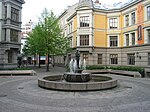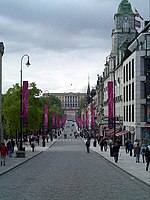Herr Nilsen Jazz Club
Jazz club stubsJazz clubs in OsloMusic venue stubsNorway stubs

Herr Nilsen Jazz Club is a jazz club in Oslo, Norway. It is located southeast of the Norwegian National Gallery, just metres north of the Hotel Bristol and Oslo Nye Teater, overlooking the courthouse square. Darwin Porter of Frommer's describes the club as "one of the most congenial spots in Oslo and a personal favorite." It often hosts internationally and nationally famous jazz musicians, with a focus on Dixieland jazz music of New Orleans.
Excerpt from the Wikipedia article Herr Nilsen Jazz Club (License: CC BY-SA 3.0, Authors, Images).Herr Nilsen Jazz Club
Rosenkrantz’ gate, Oslo Sentrum
Geographical coordinates (GPS) Address Website Nearby Places Show on map
Geographical coordinates (GPS)
| Latitude | Longitude |
|---|---|
| N 59.915277777778 ° | E 10.740555555556 ° |
Address
London Pub
Rosenkrantz’ gate
0164 Oslo, Sentrum
Norway
Open on Google Maps











